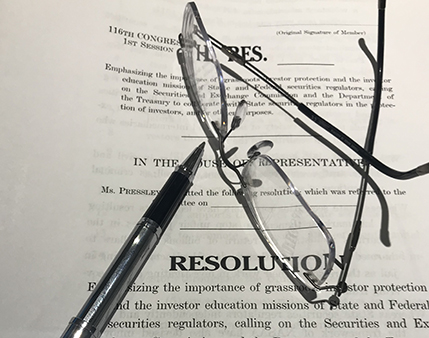Committee on Financial Services Subcommittee on Financial Institutions and Consumer Credit
“Improving Financial Literacy: Working Together to Develop Private Sector Coordination and Solutions.”
September 28, 2006
Introduction to NASAA:
The North American Securities Administrators Association (NASAA) is the oldest international organization devoted to investor protection. It was organized in 1919 and is a voluntary association with a membership consisting of 67 state, provincial and territorial securities regulators in the 50 states, the District of Columbia, Puerto Rico, the U.S. Virgin Islands, Canada, and Mexico.
These state administrators are responsible for the licensing of firms and investment professionals, registration of certain securities offerings, examination of broker-dealers and investment advisers, enforcement of state securities laws, and investor education.
Financial Education Role of State Securities Regulators:
The securities regulators that form the NASAA membership are firmly committed to promoting and supporting financial literacy, and are dedicated to delivering financial education. We believe we have an ongoing obligation to help our constituents develop the knowledge they need to make sound personal financial decisions.
We believe that reaching our young citizens with financial education at a very early age can help them build a lifetime of good money management habits. And we believe that financial education is the first and best defense against financial fraud, abuse, and exploitation. We recognize that the ability to make good financial decisions can make the difference in assuring that our citizens become and remain productive economic contributors. We also realize that the ability to make good financial decisions ultimately impacts the economic health of our families, our communities, our states, and this nation overall.
NASAA Investor Education Section:
The NASAA Investor Education Section was created in 1997 by the NASAA Board of Directors to help support the financial education efforts of our members. The Investor Education Section, along with a network of professionals from across the NASAA membership, is responsible for developing, coordinating, delivering, and supporting financial education initiatives that can be utilized by state securities regulators in their ongoing endeavor to improve the level of financial literacy in their jurisdictions.
Currently, the Section has five focus areas: Youth Outreach, Senior Outreach, Affinity and Ethnic Based Outreach, Online Resources Awareness, and General Education Program Coordination. At the Grassroots Level: Nearly all state and provincial securities regulators have established investor education departments or divisions within their agencies. The result is a unique network of dedicated professionals delivering financial education at the grassroots level throughout North America.
Our financial education professionals can be found at work in such venues as the classroom, the workplace, senior centers, and at trade and professional organization events. They partner with teachers, employers, and peer-based volunteer groups to deliver financial education to our constituents of all ages.
Specific Examples of Successful State and Provincial Programs:
The NASAA Youth Outreach Project Group created a blueprint for NASAA members to use in developing and hosting teacher-training academies. The purpose of this type of event is to train teachers on how to integrate financial education into the classroom curriculum. Through teacher training academies, we work to provide teachers with the knowledge, tools and resources they need to efficiently and effectively deliver financial education to their students. Several of our members host this type of event on an annual basis and have done so for many years.
The newly created blueprint provides a step-by-step program development guide for our members, and brings together best practices from existing, successful programs. The teacher training blueprint covers everything from structuring an agenda, suggested categories of speakers, obtaining curriculum and financial resources, coordinating lodging and meals, partnering with an institution of higher education, qualifying the event for continuing education credits, and much more.
In the area of Senior Outreach, our California member has developed a highly successful anti-fraud education program that utilizes peer-based volunteerism. The Seniors Against Investment Fraud program (SAIF) – provides seniors with a toll free call center to utilize before purchasing or investing in any type of “financial” product.
SAIF can help seniors:
- Confirm if the sales person and company are properly licensed and registered.
- Identify possible “red flags” associated with the solicitation.
- Get the facts BEFORE investing.
- Locate valuable resources to assist with investment decision making.
- Obtain information on current scams targeting seniors.
More than 1500 volunteers have been trained to carry this anti-fraud program to seniors. Volunteers include seniors, law enforcement professionals, consumer and advocacy groups, and senior service providers. The NASAA Senior Outreach project group is developing a best practices blueprint based on SAIF that will facilitate the rollout of this type of peer-based, volunteer education program across our member jurisdictions.
Partnering Relationships/Collaborations:
NASAA looks for opportunities to join forces with other members of the financial education community. NASAA believes it is essential to pool our resources and share our expertise on these joint ventures. For example, we collaborated with the Securities Industry Association to produce a Spanish version of an education tool titled “Understanding your Brokerage Account Statement” and also worked with the Investment Company Institute and the College Savings Plan Network to produce the “Guide to Understanding 529 Plans.” NASAA has also been working with the Department of Labor on their retirement preparedness program. Here again, the NASAA network of investor education professionals can be an excellent delivery vehicle for the Labor Department’s program.
Last year, we published a Fraud Awareness Quiz and the AARP will include this resource in newly created speakers’ guides for its 53 local offices. Several months ago, the Coalition on Investor Education – a broad group of consumer organizations, state securities regulators, and investment services providers released a free brochure designed to guide investors through the process of choosing an investment services provider. The coalition that produced the publication includes the Consumer Federation of America, North American Securities Administrators Association, Investment Adviser Association, Financial Planning Association, and CFA Institute.
On a regular basis, our members work with the American Savings Education Council, the Councils for Economic Education, and are involved in state level Jump$tart coalitions. We entered into a Memorandum Of Understanding with the Department of Defense through which our members will work to deliver financial education to members of the military.
State securities regulators meet annually with the financial education professionals from the Securities and Exchange Commission to engage in a dialogue about our respective programs and progress in the ongoing quest to improve financial literacy. This meeting gives us an opportunity to learn what’s new or under development, helps us identify gaps in financial education, leverage resources of our financial education colleagues, and further hone best practices. Earlier this year, NASAA and the SEC announced a joint initiative to protect senior investors. An important part of the initiative will involve investor education and outreach to senior investors.
NASAA’s General Education Program Coordination Project Group has compiled an Investor Education Resource Directory that contains the names and contact information for more than 130 groups in order to make it easier for NASAA members to reach out and coordinate educational efforts with other groups and agencies. A library of NASAA member educational PowerPoint presentations is also being compiled to enable members to more easily coordinate educational outreach efforts.
Resources:
Through the NASAA Web site at www.nasaa.org, visitors will find a wealth of information to help them build both financial knowledge and financial security. Among other educational experiences on the NASAA Web site, visitors can utilize the Senior Investor Resource Center and the NASAA Fraud Center, learn more about the Financial Literacy 2010 curriculum designed for junior high and high school students, and locate state and provincial-specific resources available through individual NASAA members.
In order to share its resources, NASAA compiled a directory of investor education publications, public service announcements, and investor education videos of its members both by category and by jurisdiction. The directory includes publications of NASAA members translated into Spanish, French, Chinese, Russian, Polish, and Tamil. This valuable tool is accessible on NASAA’s Web site for use by the public as well as NASAA members that might have a need for a resource of a different subject matter.
Conclusion:
State securities regulators have traditionally been a highly effective resource in the pursuit of greater financial literacy. They represent a nationwide network of highly trained, unbiased, non-commercial experts in financial services, products and fraud avoidance. They are on the front lines of financial education initiatives in every state, translating Wall Street to Main Street for small investors throughout the country. NASAA and its members welcome the opportunity to work more closely with the Subcommittee members in their ongoing efforts to improve the level of financial literacy throughout the country.
September 28, 2006











